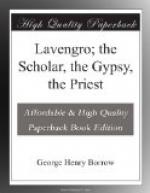I am not going to enter into farther details with respect to the process—it was rather a wearisome one. I had to contend with various disadvantages; my forge was a rude one, my tools might have been better; I was in want of one or two highly necessary implements, but, above all, manual dexterity. Though free of the forge, I had not practised the albeytarian art for very many years, never since—but stay, it is not my intention to tell the reader, at least in this place, how and when I became a blacksmith. There was one thing, however, which stood me in good stead in my labour, the same thing which through life has ever been of incalculable utility to me, and has not unfrequently supplied the place of friends, money, and many other things of almost equal importance—iron perseverance, without which all the advantages of time and circumstance are of very little avail in any undertaking. I was determined to make a horse-shoe, and a good one, in spite of every obstacle—ay, in spite of dukkerin. At the end of four days, during which I had fashioned and refashioned the thing at least fifty times, I had made a petul such as no master of the craft need have been ashamed of; with the second shoe I had less difficulty, and, by the time I had made the fourth, I would have scorned to take off my hat to the best smith in Cheshire.
But I had not yet shod my little gry: this I proceeded now to do. After having first well pared the hoofs with my churi, I applied each petul hot, glowing hot, to the pindro. Oh, how the hoofs hissed! and, oh, the pleasant pungent odour which diffused itself through the dingle!—an odour good for an ailing spirit.




